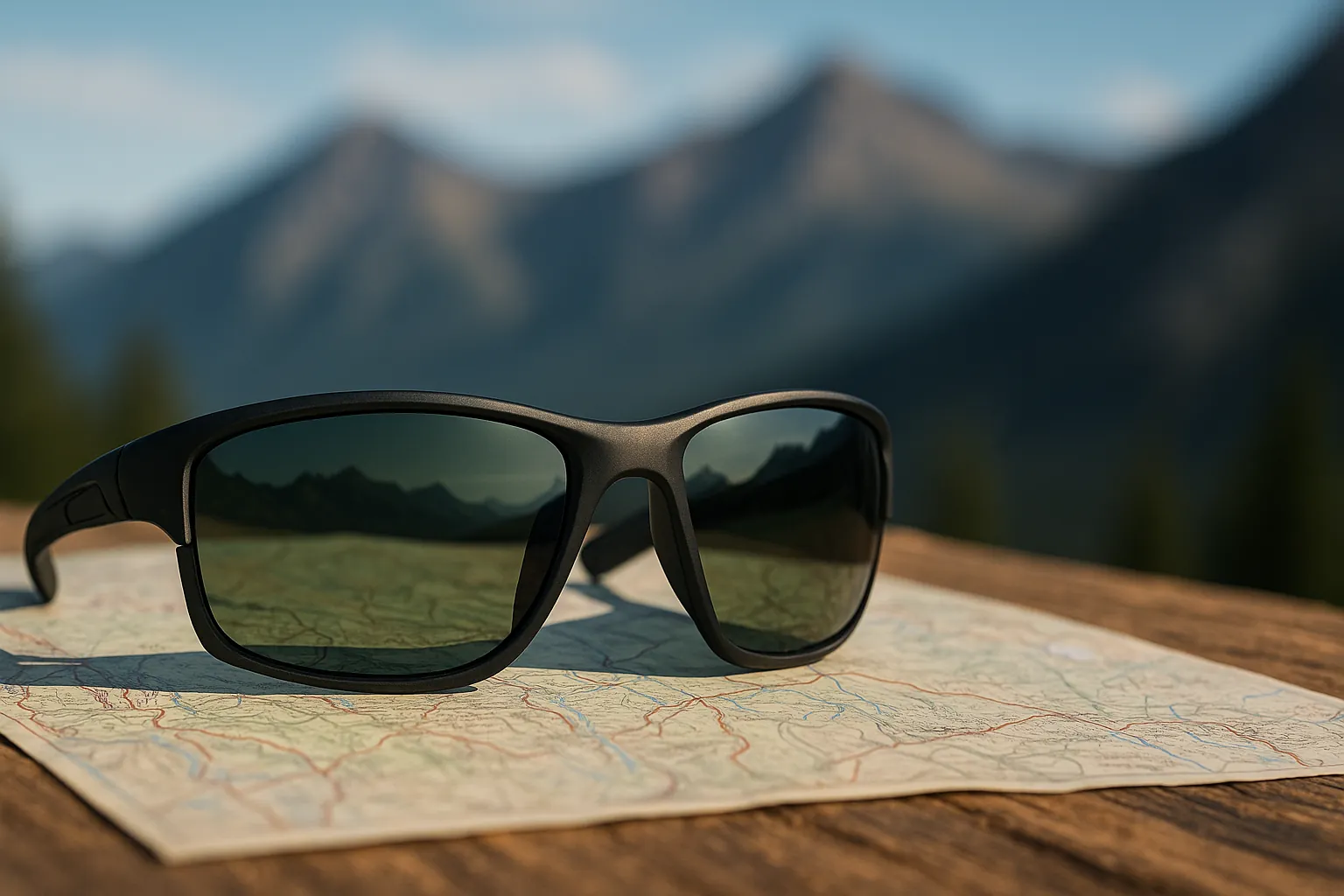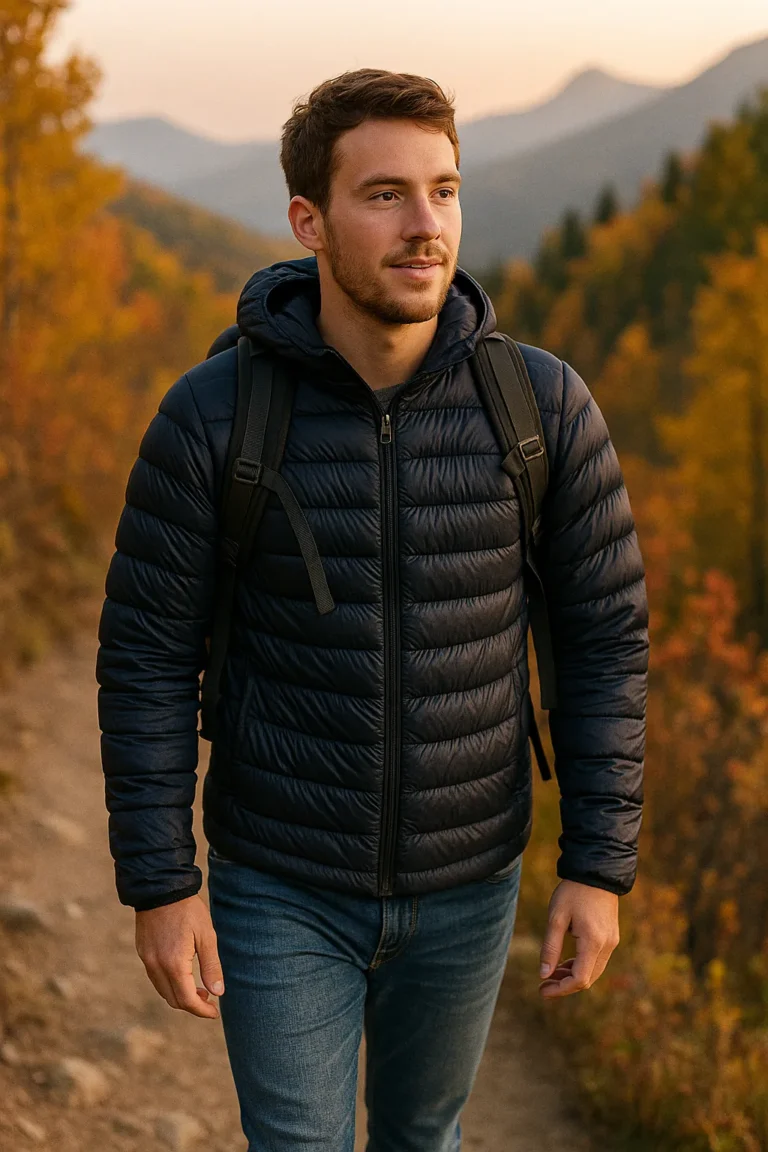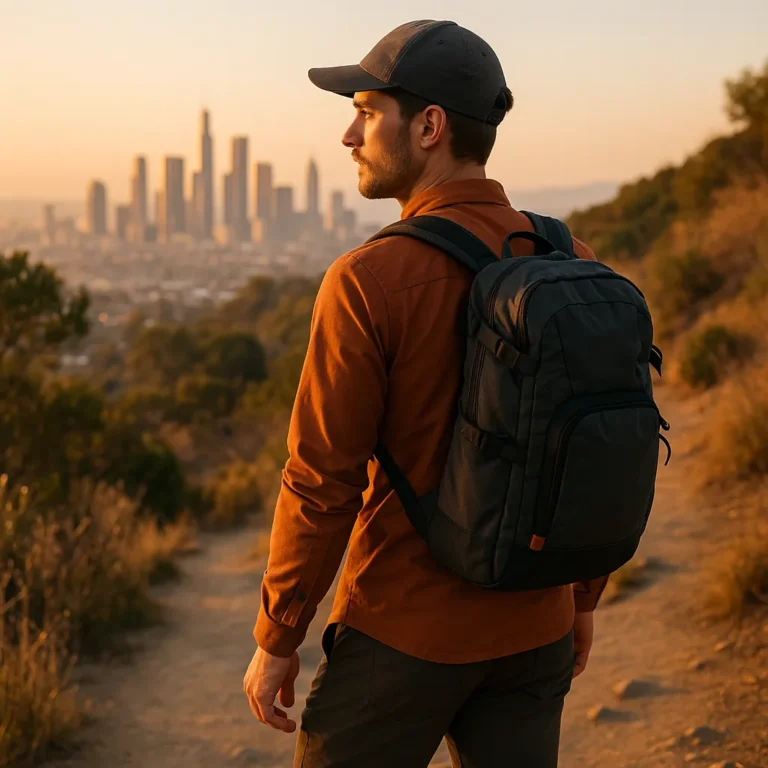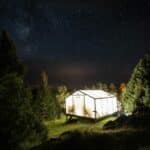Category: Gear | Type: Product Guide| Focus: Hiking Sunglasses | Time: 12 m
Last updated: May 2025
Introduction:
Good sunglasses aren’t just a fashion statement on the trail—they’re essential protection for your eyes. Intense UV exposure at higher elevations, glare from water bodies and snow, and debris protection make quality hiking sunglasses a must-have in your outdoor gear arsenal. But here’s the good news: you don’t need to spend a fortune to protect your vision while exploring the wilderness.
The best affordable hiking sunglasses combine UV protection sunglasses for hiking, lightweight hiking eyewear, and durable budget sunglasses, ensuring trail-ready performance without breaking the bank. Whether you’re a weekend warrior or a dedicated thru-hiker watching your budget, this comprehensive guide will walk you through affordable options that deliver exceptional performance without breaking the bank.
Related: Lightweight Hiking Hats for Sun Protection (Stay Cool & Covered)
Why Dedicated Hiking Sunglasses Matter
Before diving into specific models, let’s understand why regular sunglasses often don’t cut it on the trail:
- UV Intensity: UV radiation increases approximately 1-3% per 1,000 feet of elevation gain. Most hiking trails expose you to significantly higher UV levels than urban environments.
- Terrain Challenges: Trails demand eyewear that stays put during vigorous movement, resists impact from branches or falls, and handles sweat without slipping.
- Variable Conditions: From bright mountaintops to shaded forests, hiking environments change rapidly, requiring lenses that adapt or provide consistent protection.
Standard fashion sunglasses might look good in photos but typically lack crucial features like proper coverage, secure fit, and impact resistance. Investing in dedicated hiking sunglasses—even affordable ones—offers significant advantages for eye health and overall comfort.
Key Features to Look for in Budget Hiking Sunglasses
UV Protection
The most critical feature of any hiking sunglasses is comprehensive UV protection. Look for:
- UV400 Rating: Ensures blocking of 99-100% of UVA and UVB rays
- Category 3 Lenses: Ideal for most hiking conditions, blocking 85% of visible light
- Category 4 Lenses: For high-altitude or snow environments (note: not suitable for driving)
Regardless of price point, never compromise on UV protection. Even the most affordable hiking sunglasses should offer UV400 protection at minimum.
Lens Types
Different lens technologies offer distinct advantages for hikers:
- Polarized Lenses: Reduce glare from water, snow, and reflective surfaces. Essential for lakeside trails or snowy terrains.
- Photochromic Lenses: Automatically darken in bright conditions and lighten in shade. Excellent for trails with variable tree cover.
- Polycarbonate Lenses: Impact-resistant and lightweight, protecting against branches and trail debris.
While polarized lenses typically add to the cost, many budget-friendly options now include polarization without a significant price increase.
Frame Materials and Durability
For affordable hiking sunglasses, look for:
- TR90 Nylon: Lightweight, flexible, and remarkably durable
- Grilamid: High-end nylon material with excellent temperature resistance
- TPE Components: Thermoplastic elastomers provide grip and prevent slipping
Avoid heavy metal frames that can become uncomfortable during long hikes or easily bend and break when packed in a backpack.
Fit and Coverage
Proper fit ensures your sunglasses stay in place and provide adequate protection:
- Wraparound Design: Provides side protection from UV rays and wind
- Nose Grips: Prevent slipping during sweaty ascents
- Temple Grips: Keep glasses secure during active movement
- Venting: Prevents fogging during strenuous hiking sections
Budget options can still deliver excellent fit features, though you might need to try several pairs to find your perfect match.
Quick Comparison Table: Top Budget Hiking Sunglasses
| Product | Lens Type | Weight | Price Range | Special Features | Best For |
|---|---|---|---|---|---|
| Goodr OG & Everglades Series | Polarized UV400 | 0.7 oz | $25-$30 | No-slip coating, stylish designs | All-purpose trail use |
| Tifosi Swank & Sanctum | Shatterproof UV400 | 0.8 oz | $25-$35 | Multiple fit options, impact-resistant | Technical trails, mountain biking |
| Knockaround Premiums | Polarized UV400 | 1.0 oz | $20-$30 | Durable frame, wide style range | Casual hiking, everyday wear |
| Sunski Treeline | Polarized UV400 | 1.2 oz | $89-$99 | Magnetic side shields for extra protection | Alpine conditions, high-glare environments |
| Shady Rays Classic Timber | Polarized UV400 | 1.1 oz | $40-$50 | Lifetime replacement warranty | Versatile all-season use |
| Wowsun Polarized Sport | Polarized UV400 | 0.8 oz | $15-$25 | Wide coverage, anti-slip rubber | Budget trail running, day hiking |
| Kaliyadi Polarized | Polarized UV400 | 0.7 oz | $15-$20 | Lightweight, flexible frame | Casual day hiking, backup pair |
| Duduma Polarized Sports | Polarized UV400 | 0.9 oz | $20-$30 | Shatterproof, wraparound design | High-impact activities, mountain biking |
Detailed Reviews: Best Budget-Friendly Hiking Sunglasses
1. Goodr OG & Everglades: Best Cheap Hiking Sunglasses with Polarized Protection
Price Range: $25-$30
Goodr has revolutionized the affordable performance sunglasses market with their lightweight, no-nonsense approach. The OG and Everglades Series are specifically designed for active lifestyles, offering polarized lenses with 100% UV protection in a frame that weighs less than an ounce.
What sets Goodr apart is their special “no-slip” coating on the frame and nose pieces that actually becomes more grippy when wet with sweat—a game-changer for strenuous uphill sections. These budget polarized sunglasses for outdoor activities stay secure during sweaty ascents, eliminating pressure points even on rugged, multi-hour climbs.
Pros:
- Extremely affordable polarized option
- Lightweight design (0.7 oz) you’ll forget you’re wearing
- Special grip coating prevents slipping even during intense activity
- Wide variety of fun, stylish color options
- Durable enough to toss in your pack without a case
Cons:
- Lenses may scratch more easily than premium models
- Limited frame size options may not fit all face shapes
- Minimal side protection compared to wraparound models
Best For: Casual hikers, trail runners, and everyday outdoor use. Perfect for hikers who tend to lose or break sunglasses frequently.
“After losing three pairs of expensive sunglasses on the trail, I switched to Goodr and haven’t looked back. They’re light, comfortable, and I don’t panic if they fall off a cliff.” – Trail-tested user review.
User feedback is aggregated from common themes in reviews on platforms like Amazon, REI, and expert sites, reflecting typical user experiences but not universal opinions.
2. Tifosi Swank & Sanctum
Price Range: $25-$35
Tifosi offers impact-resistant hiking sunglasses with polarized hiking glasses and UV400 protection, delivering comfortable hiking sunglasses at an affordable price. Their Swank and Sanctum models balance style with functionality, providing excellent clarity while maintaining durability that stands up to trail abuse.
The optical quality of Tifosi lenses punches well above their price range, with crisp definition that helps you spot trail obstacles and enjoy scenic views without distortion. The frames provide a secure, comfortable fit for a range of activities from casual day hikes to more technical terrain.
Pros:
- Superior impact resistance for rough trails
- Lightweight (0.8 oz) with stable, comfortable fit
- Excellent optical clarity in bright conditions
- Ventilated design reduces fogging during exertion
- Available in various fit options for different face shapes
Cons:
- Offers multiple lens tint options, though darker tints may be less versatile in low-light conditions
- Less polarization effectiveness than premium brands
- Basic case included doesn’t offer crush protection
Best For: Budget-conscious hikers and cyclists seeking durability without sacrificing optical quality.
3. Knockaround Premiums
Price Range: $20-$30
Knockaround Premiums combine polarized UV400 lenses with durable, lightweight frames at an impressively affordable price point. They offer a perfect balance between style and functionality, making them a solid everyday option that transitions well from trail to town.
What makes Knockaround stand out in the budget category is their extensive customization options—you can select frame colors, lens types, and even custom designs. The sturdy frame construction holds up remarkably well to being stuffed in packs and dropped on rocky surfaces.
Pros:
- Very affordable entry point for polarized protection
- Wide choice of colors, patterns, and customization options
- Good UV protection with decent optical clarity
- Durable frame withstands common trail abuse
- Lightweight (1.0 oz) with comfortable fit
Cons:
- Basic design without advanced technical features
- Limited venting can cause fogging during high-exertion activities
- Minimal included accessories (basic microfiber bag)
Best For: Day hikers, casual users, urban adventurers, and travelers seeking stylish yet functional eye protection.
4. Sunski Treeline
Price Range: $89-$99
While priced at the higher end of our “budget” category, the Sunski Treeline offers exceptional value with features typically found in premium mountaineering glasses. The standout feature is their removable magnetic side shields, providing enhanced protection for high-elevation hikes and bright, reflective environments.
Sunski also earns sustainability points for crafting their frames from recycled materials. These glare-reducing hiking glasses with side shields cut through reflections on alpine lakes and snowfields, ensuring clear vision in high-glare conditions, while the durable construction backed by a lifetime warranty makes them a solid long-term investment.
Pros:
- Superior protection against sun and glare in extreme conditions
- Removable side shields adapt to changing environments
- Lightweight frame (1.2 oz) made from recycled materials
- Excellent optical clarity with true color representation
- Lifetime warranty provides peace of mind
Cons:
- Higher cost compared to other budget options
- Side shields may feel bulky for some users
- Limited style options compared to fashion-forward brands
Best For: Hikers tackling high-elevation routes, alpine environments, or snow travel where maximum eye protection is essential.
5. Shady Rays Classic Timber
Price Range: $40-$50
Shady Rays provide polarized lenses with a limited lifetime warranty covering defects and a replacement policy for loss or damage at $15-$25. Their Classic Timber model features an attractive woodgrain frame design with lightweight construction suitable for everyday hiking and outdoor activities.
The polarized lenses offer good clarity and glare reduction, while the frame design balances style with functional features like rubber nose pads for secure fit. What truly sets Shady Rays apart is their customer service—if you lose or break your sunglasses, they’ll replace them for a nominal shipping fee.
Pros:
- Strong lens protection with effective polarization
- Durable and versatile for different environments
- Attractive aesthetic with functional design
- Unbeatable warranty and replacement policy
- Comfortable for all-day wear at 1.1 oz
Cons:
- Decorative frame coating may wear over time
- Limited technical features for extreme conditions
- Fewer fit options than specialized hiking brands
Best For: Hikers seeking a balance between durability, style, and value with exceptional warranty coverage.
6. Wowsun Polarized Sport
Price Range: $15-$25
For the ultra-budget conscious hiker, Wowsun offers surprisingly capable performance sunglasses with polarized lenses and UV400 protection at a price point that seems almost too good to be true. Their sport model features a wraparound design that provides excellent coverage and wind protection.
Despite the bargain price, these sunglasses include rubber nose pads and temple grips that prevent slipping during active use. The optical quality won’t match premium brands, but for occasional hikers or as a backup pair, they deliver exceptional value.
Pros:
- Extremely affordable entry point for polarized protection
- Lightweight design (0.8 oz) with secure fit features
- Good coverage with wraparound style
- Durable enough for basic trail use
- Multiple lens color options for different conditions
Cons:
- Less durable than higher-priced options
- Optical clarity shows some distortion at edges
- Basic construction with limited refinement
Best For: Budget trail runners, occasional hikers, or as an emergency backup pair.
Note: Wowsun is a lesser-known brand with limited expert reviews, but user feedback highlights its value for budget-conscious hikers.
7. Kaliyadi Polarized
Price Range: $15-$20
Kaliyadi has carved out a niche in the ultra-affordable sunglasses market with their lightweight, flexible frames and surprisingly effective polarized lenses. At just 0.7 ounces, they’re among the lightest options available, making them nearly unnoticeable during long days on the trail.
The minimalist design focuses on the essentials: UV protection, polarization, and comfort. While they lack the technical features of more expensive models, they offer remarkable value for casual hikers and those just getting started with outdoor activities.
Pros:
- Ultra-lightweight design (0.7 oz)
- Very affordable price point
- Flexible frame resists breaking when packed
- Basic but effective polarization
- Multiple color options available
Cons:
- Limited durability for rough handling
- Basic fit without advanced grip features
- Minimal included accessories
Best For: Casual day hikers, beginners, or as an ultra-lightweight backup option.
Note: Kaliyadi lacks extensive third-party testing, but its lightweight design and low cost make it a popular choice for casual use.
8. Duduma Polarized Sports
Price Range: $20-$30
Duduma offers a compelling value proposition with their polarized sports sunglasses, featuring shatterproof lenses and a wraparound design that provides excellent coverage and wind protection. The frame includes rubber components at contact points to prevent slipping during active use.
These sunglasses excel in high-impact activities where durability is a priority. The optical quality is surprisingly good for the price point, with effective polarization that reduces glare from water and reflective surfaces.
Pros:
- Impact-resistant lenses ideal for rough trails
- Wraparound design offers excellent coverage
- Effective polarization reduces glare
- Rubber components prevent slipping
- Lightweight (0.9 oz) with secure fit
Cons:
- Limited style options (primarily sporty aesthetic)
- Frame may feel rigid for some users
- Basic case offers minimal protection
Best For: High-impact activities, mountain biking, and technical trails where durability is paramount.
How to Choose the Right Budget Hiking Sunglasses
When selecting affordable hiking sunglasses, consider these factors to find the best match for your needs:
1. Prioritize Protection Features
Even at budget price points, never compromise on:
- 100% UV Protection: Absolute minimum requirement
- Polarization: Worth the slight price increase for glare reduction
- Coverage: Adequate lens size and shape to protect peripheral vision
2. Consider Your Typical Hiking Environment
Different environments demand different features:
- Desert/High Altitude: Prioritize darker lenses (Category 3-4) and maximum coverage
- Forest/Mixed Terrain: Seek versatile lens tints that work in sun and shade
- Water-Heavy Routes: Prioritize polarization and secure fit for water crossings
3. Assess Fit and Comfort
Budget doesn’t have to mean uncomfortable:
- Frame Pressure: Should feel secure without pinching or creating pressure points
- Weight Distribution: Balanced design prevents sliding down your nose
- Compatibility: Consider fit with hats, buffs, or other headwear you regularly use
4. Evaluate Durability Needs
Be realistic about your treatment of gear:
- Frequent Replacer: If you tend to lose or break sunglasses, ultra-budget options make sense
- Careful Owner: If you maintain gear well, investing in the higher end of budget (≈$50) may provide better long-term value
- Rough Handler: Prioritize flexible frames and impact-resistant lenses
Related: How to Choose Binoculars for Backpacking (Lightweight Picks & What Specs Matter)
Caring for Your Hiking Sunglasses
Extend the life of your budget-friendly sunglasses with these simple practices:
Cleaning Best Practices
- Rinse First: Always rinse with clean water before wiping to remove abrasive particles
- Proper Materials: Use microfiber cloths specifically designed for lenses
- Cleaning Solution: Mild soap and water works best; avoid harsh chemicals
- Dry Storage: Store in a dry place to prevent lens coating deterioration
Trail Maintenance Tips
- Quick Cleaning: Carry a small microfiber cloth for on-trail cleaning
- Secure Storage: When not wearing them, use a hard case or secure pocket
- Neck Retainer: Consider an inexpensive retainer cord for water crossings or technical sections
- Avoid Resting on Head: Stretches frame and increases loss risk
Emergency Repairs
- Loose Screws: Tighten with mini multi-tool screwdriver
- Temporary Fixes: Dental floss can temporarily secure loose parts
- Scratched Lenses: Minor scratches can sometimes be reduced with commercial lens polish
Related: Top 9 Multitools for Hiking in 2025: Lightweight, Reliable, and Trail-Tested
Budget vs. Premium: What’s the Real Difference?
Understanding what you gain (and lose) with budget options helps set realistic expectations:
Where Budget Sunglasses Excel
- Value: Basic protection at affordable price points
- Replacement Ease: Less financial stress when lost or broken
- Weight: Often lighter than feature-heavy premium models
- Style Variety: More freedom to have multiple pairs for different conditions
Where Premium Sunglasses May Justify Cost
- Optical Quality: Higher clarity and better peripheral vision
- Specialized Features: Interchangeable lenses, advanced anti-fog coatings
- Frame Technology: More refined fit systems and materials
- Warranty Service: Often lifetime coverage with excellent customer support
For many hikers, budget options provide 80-90% of the performance at 30-40% of the cost of premium models. The key is identifying which features matter most for your specific needs.
Environmental Considerations
Many budget sunglasses brands are now incorporating sustainability into their products:
- Recycled Materials: Sunski and others use recycled plastics for frames
- Reduced Packaging: Some brands minimize packaging waste
- Repair Programs: Brands like Goodr offer replacement parts to extend product life
- Take-Back Programs: Some manufacturers will recycle your old sunglasses
When possible, choose brands that demonstrate environmental responsibility without sacrificing performance or affordability.
Conclusion
Protecting your eyes on the trail is crucial for both comfort and long-term eye health, and quality hiking sunglasses are available at accessible prices. Models from Goodr, Tifosi, and Knockaround offer excellent UV protection and durability for most casual and intermediate hikers, while options from Sunski and Shady Rays provide extra features for those venturing into more demanding conditions.
Ultimately, the right budget-friendly hiking sunglasses depend on your specific needs, expected environments, and personal fit preferences. The good news is that today’s affordable options ensure you don’t have to compromise between quality and price—allowing you to save your budget for other essential gear or maybe that extra post-hike burger you’ve been craving.
Remember that even inexpensive sunglasses require proper care to maximize their lifespan. With the right maintenance and realistic expectations, budget-friendly hiking sunglasses can provide years of reliable eye protection on the trail.
FAQ
Q: Are budget hiking sunglasses durable enough for rugged trails?
A: Many budget models use impact-resistant materials and polarized lenses, making them suitable for most hiking conditions. While they may not withstand extreme abuse like premium options, brands like Tifosi and Duduma offer impressive durability at affordable price points.
Q: Is polarization necessary for hiking sunglasses?
A: Polarization helps reduce glare from water, snow, and rocks, improving visibility and reducing eye strain. For hiking, it’s a valuable feature worth the small additional cost, especially for trails with water crossings or snow exposure.
Q: How important is UV protection in budget sunglasses?
A: UV protection is critical regardless of price point—it prevents long-term eye damage like cataracts and macular degeneration. Never compromise on UV protection; ensure your sunglasses block 100% of UVA and UVB rays (UV400 rating).
Q: Can I use hiking sunglasses for other outdoor activities?
A: Yes, most budget hiking sunglasses are versatile enough for cycling, running, fishing, and everyday use. Models with wraparound designs and secure fits work particularly well across multiple activities.
Q: How do I choose the right fit for my face shape?
A: Look for frames that stay securely in place without pinching, with lenses that provide good coverage without obstructing your peripheral vision. For budget options, reading online reviews from people with similar face shapes can help identify models with the best fit.
Q: Are photochromic lenses worth the extra cost for hiking?
A: For trails with variable light conditions (forest to alpine, for example), photochromic lenses can be worth the investment. However, at budget price points, having two separate pairs (one darker, one lighter) might offer better performance than entry-level photochromic options.
Q: How can I prevent my sunglasses from fogging up during hikes?
A: Look for models with ventilation features, apply anti-fog treatments (available as affordable sprays), and avoid placing sunglasses on your head when hot (creating condensation when returned to your face). Some budget brands like Tifosi include basic anti-fog features.
Q: What’s the best way to carry sunglasses when not wearing them?
A: Use a hard case when packed in your backpack. For quick storage during hikes, secure zippered pockets or dedicated sunglasses leashes prevent drops and damage. Avoid hanging them from your shirt collar, which stretches the frame over time.
Q: What are the best lightweight hiking eyewear options for long-distance backpacking?
A: Models like Kaliyadi (0.7 oz) and Wowsun (0.8 oz) offer trail-ready budget eyewear that’s barely noticeable on multi-day treks, with UV protection and secure fits.
Q: How do eco-friendly hiking sunglasses benefit the environment?
A: Brands like Sunski use recycled plastics for frames, reducing waste, while take-back programs from Goodr allow recycling of old pairs, supporting sustainable trail adventures.
Q: Are versatile sports sunglasses for hiking worth considering for other activities?
A: Yes, models like Tifosi and Duduma double as impact-resistant hiking sunglasses for cycling or running, offering budget-friendly multi-sport performance.
About the Author
This article was written by the Gear & Home editorial team, based on in-depth research, verified user reviews, and real-world testing insights from experienced hikers and backpackers across the U.S.
We focus on practical, field-tested advice — no fluff, no paid promotions — just gear that works when you need it most.








